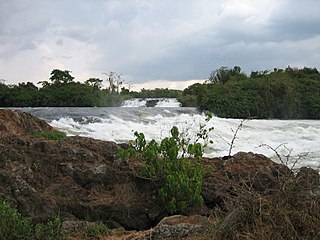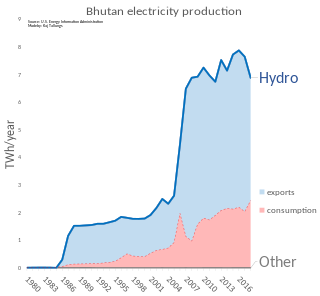
Hydroelectricity, or hydroelectric power, is electricity generated from hydropower. Hydropower supplies 15% of the world's electricity, almost 4,210 TWh in 2023, which is more than all other renewable sources combined and also more than nuclear power. Hydropower can provide large amounts of low-carbon electricity on demand, making it a key element for creating secure and clean electricity supply systems. A hydroelectric power station that has a dam and reservoir is a flexible source, since the amount of electricity produced can be increased or decreased in seconds or minutes in response to varying electricity demand. Once a hydroelectric complex is constructed, it produces no direct waste, and almost always emits considerably less greenhouse gas than fossil fuel-powered energy plants. However, when constructed in lowland rainforest areas, where part of the forest is inundated, substantial amounts of greenhouse gases may be emitted.

Southern California Edison (SCE), the largest subsidiary of Edison International, is the primary electric utility company for much of Southern California. It provides 15 million people with electricity across a service territory of approximately 50,000 square miles.

The Manitoba Hydro-Electric Board, operating as Manitoba Hydro, is the electric power and natural gas utility in the province of Manitoba, Canada. Founded in 1961, it is a provincial Crown Corporation, governed by the Manitoba Hydro-Electric Board and the Manitoba Hydro Act. Today the company operates 16 interconnected generating stations. It has more than 527,000 electric power customers and more than 263,000 natural gas customers. Since most of the electrical energy is provided by hydroelectric power, the utility has low electricity rates. Stations in Northern Manitoba are connected by a HVDC system, the Nelson River Bipole, to customers in the south. The internal staff are members of the Canadian Union of Public Employees Local 998 while the outside workers are members of the International Brotherhood of Electrical Workers Local 2034.

American Electric Power Company, Inc. (AEP), is an American domestic electric utility company in the United States. It is one of the largest electric utility companies in the country, with more than five million customers in 11 states.

The electricity sector in Canada has played a significant role in the economic and political life of the country since the late 19th century. The sector is organized along provincial and territorial lines. In a majority of provinces, large government-owned integrated public utilities play a leading role in the generation, transmission, and distribution of electricity. Ontario and Alberta have created electricity markets in the last decade to increase investment and competition in this sector of the economy.

Constellation Energy Corporation is an American energy company headquartered in Baltimore, Maryland. The company provides electric power, natural gas, and energy management services. It has approximately two million customers across the continental United States.

Pine Ridge is an unincorporated community in Hale Township, Caddo County, Oklahoma, United States. It is located 6 miles (10 km) south of Fort Cobb at the junction of County Road 1380 and County Street 2550.

Burning of renewable resources provides approximately 90 percent of the energy in Uganda, though the government is attempting to become energy self-sufficient. While much of the hydroelectric potential of the country is untapped, the government decision to expedite the creation of domestic petroleum capacity coupled with the discovery of large petroleum reserves holds the promise of a significant change in Uganda's status as an energy-importing country.
According to the International Hydropower Association, Canada is the fourth largest producer of hydroelectricity in the world in 2021 after the United States, Brazil, and China. In 2019, Canada produced 632.2 TWh of electricity with 60% of energy coming from Hydroelectric and Tidal Energy Sources).

Idaho Power Company (IPC) is a regulated electrical power utility. Its business involves the purchase, sale, generation, transmission and distribution of electricity in eastern Oregon and southern Idaho. It is a subsidiary of IDACORP, Inc. The company's 24,000-square-mile (62,000 km2) service area generally follows the area around the Snake River and its tributaries.

The Bujagali Power Station is a hydroelectric power station across the Victoria Nile that harnesses the energy of its namesake, the Bujagali Falls, in Uganda. Construction began in 2007 and concluded in 2012. It was officially inaugurated on 8 October 2012 by Ugandan President Yoweri Museveni and Aga Khan IV in the presence of African politicians and investors.

Energy in Bhutan has been a primary focus of development in the kingdom under its Five-Year Plans. In cooperation with India, Bhutan has undertaken several hydroelectric projects whose output is traded between the countries. Though Bhutan's many hydroelectric plants provide energy far in excess of its needs in the summer, dry winters and increased fuel demand makes the kingdom a marginal net importer of energy from India.

The U.S. State of Oklahoma has high potential capacity for wind power in the western half of the state. In 2021, Oklahoma's installed wind generation capacity was almost 10,500 megawatts, supplying over 40% of the state's generated electricity and 85% of Oklahoma's total generating capacity from all renewable resources.
The John W. Turk Jr. Coal Plant typically operates at an average load of 600 Megawatts 350 Megawatts can be run..load power can be|Base load-350 Max load-650 Megawatts]] Depending on the demand of the power grid. Which is regulated by a centralized grid that distributes power throughout Arkansas and other states. megawatt coal-fired power station in Fulton, Arkansas, operated by the American Electric Power subsidiary Southwestern Electric Power Company (SWEPCO). It provides power to customers in Arkansas, Louisiana, and Texas.
The United States state of Arkansas is a significant producer of natural gas and a minor producer of petroleum.
Bujagali Energy Limited (BEL) is an electric energy generating company in Uganda. The company owns and operates the Bujagali Power Station, the largest hydropower plant in the country as of July 2014.
Wind power in Arkansas remains nearly untapped, with just a single wind turbine in the state. Arkansas does not have a renewable portfolio standard. Studies have concluded that while Arkansas is generally considered to have low wind resources, there are significant pockets of it throughout the state.











